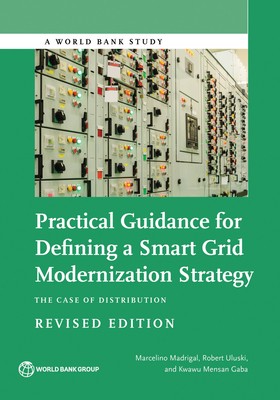
- We will send in 10–14 business days.
- Author: Marcelino Madrigal
- Publisher: World Bank Publications
- ISBN-10: 1464810540
- ISBN-13: 9781464810541
- Format: 17.8 x 25.4 x 1 cm, softcover
- Language: English
- SAVE -10% with code: EXTRA
Practical Guidance for Defining a Smart Grid Modernization Strategy (e-book) (used book) | bookbook.eu
Reviews
Description
Practical Guidance for Defi ning a Smart Grid Modernization Strategy: The Case of Distribution guides stakeholders on how utilities can defi ne their own smart grid vision, identify priorities, and structure investment plans. While most of these strategic aspects apply to any area of the electricity grid, the book focuses on distribution. The guidance includes key building blocks for modernizing the distribution grid and provides examples of grid modernization projects. This revised edition also includes key communication system requirements to support a well-functioning grid. The concept of the smart grid is relevant to all grids. What varies are the magnitude and type of the incremental steps toward modernization for achieving a specifi c smart grid vision. A utility that is at a relatively low level of grid modernization may leapfrog one or more levels of modernization to achieve some of the benefi ts of the highest levels of grid modernization. Smart grids impact electric distribution systems signifi cantly. In developing countries, modernizing the distribution grid promises to benefi t the operation of electric distribution utilities in many and various ways. These benefi ts include improved operational effi ciency (such as reduced losses and lower energy consumption), reduced peak demand, improved service reliability, and ability to accommodate distributed generating resources without adversely impacting overall power quality. Practical Guidance for Defi ning a Smart Grid Modernization Strategy concludes by describing funding and regulatory issues that may need to be taken into account when developing smart grid plans. The World Bank Studies series is available for free download online through the Open Knowledge Repository (https: //openknowledge.worldbank.org)
EXTRA 10 % discount with code: EXTRA
The promotion ends in 20d.09:37:12
The discount code is valid when purchasing from 10 €. Discounts do not stack.
- Author: Marcelino Madrigal
- Publisher: World Bank Publications
- ISBN-10: 1464810540
- ISBN-13: 9781464810541
- Format: 17.8 x 25.4 x 1 cm, softcover
- Language: English English
Practical Guidance for Defi ning a Smart Grid Modernization Strategy: The Case of Distribution guides stakeholders on how utilities can defi ne their own smart grid vision, identify priorities, and structure investment plans. While most of these strategic aspects apply to any area of the electricity grid, the book focuses on distribution. The guidance includes key building blocks for modernizing the distribution grid and provides examples of grid modernization projects. This revised edition also includes key communication system requirements to support a well-functioning grid. The concept of the smart grid is relevant to all grids. What varies are the magnitude and type of the incremental steps toward modernization for achieving a specifi c smart grid vision. A utility that is at a relatively low level of grid modernization may leapfrog one or more levels of modernization to achieve some of the benefi ts of the highest levels of grid modernization. Smart grids impact electric distribution systems signifi cantly. In developing countries, modernizing the distribution grid promises to benefi t the operation of electric distribution utilities in many and various ways. These benefi ts include improved operational effi ciency (such as reduced losses and lower energy consumption), reduced peak demand, improved service reliability, and ability to accommodate distributed generating resources without adversely impacting overall power quality. Practical Guidance for Defi ning a Smart Grid Modernization Strategy concludes by describing funding and regulatory issues that may need to be taken into account when developing smart grid plans. The World Bank Studies series is available for free download online through the Open Knowledge Repository (https: //openknowledge.worldbank.org)


Reviews